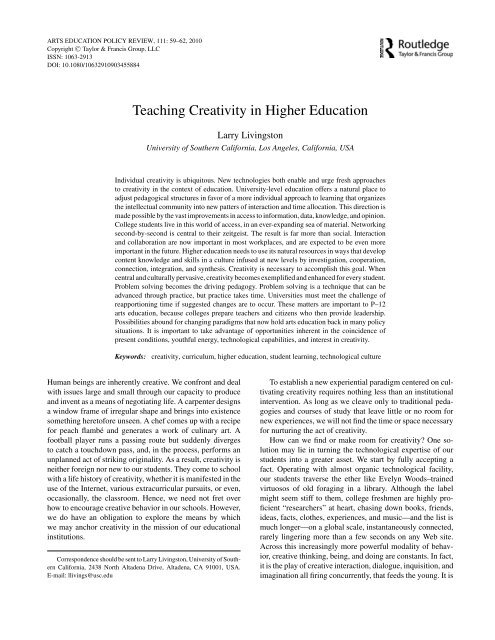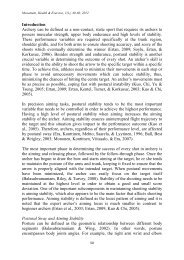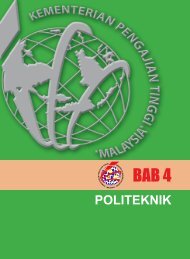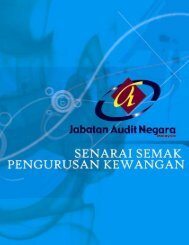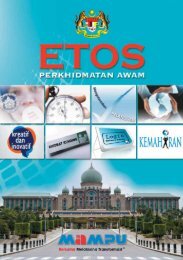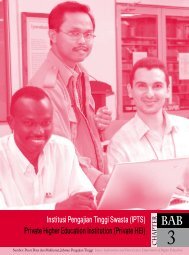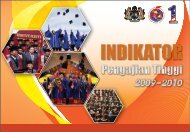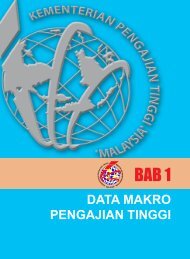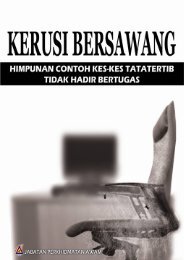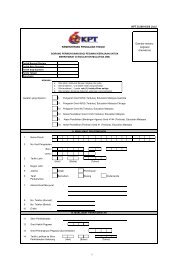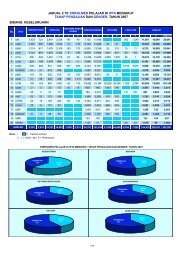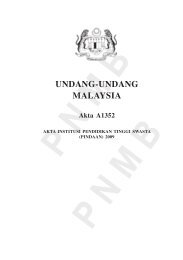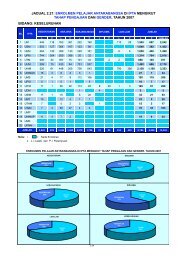Baca artikel
Baca artikel
Baca artikel
Create successful ePaper yourself
Turn your PDF publications into a flip-book with our unique Google optimized e-Paper software.
ARTS EDUCATION POLICY REVIEW, 111: 59–62, 2010<br />
Copyright C○ Taylor & Francis Group, LLC<br />
ISSN: 1063-2913<br />
DOI: 10.1080/10632910903455884<br />
Teaching Creativity in Higher Education<br />
Larry Livingston<br />
University of Southern California, Los Angeles, California, USA<br />
Individual creativity is ubiquitous. New technologies both enable and urge fresh approaches<br />
to creativity in the context of education. University-level education offers a natural place to<br />
adjust pedagogical structures in favor of a more individual approach to learning that organizes<br />
the intellectual community into new patters of interaction and time allocation. This direction is<br />
made possible by the vast improvements in access to information, data, knowledge, and opinion.<br />
College students live in this world of access, in an ever-expanding sea of material. Networking<br />
second-by-second is central to their zeitgeist. The result is far more than social. Interaction<br />
and collaboration are now important in most workplaces, and are expected to be even more<br />
important in the future. Higher education needs to use its natural resources in ways that develop<br />
content knowledge and skills in a culture infused at new levels by investigation, cooperation,<br />
connection, integration, and synthesis. Creativity is necessary to accomplish this goal. When<br />
central and culturally pervasive, creativity becomes exemplified and enhanced for every student.<br />
Problem solving becomes the driving pedagogy. Problem solving is a technique that can be<br />
advanced through practice, but practice takes time. Universities must meet the challenge of<br />
reapportioning time if suggested changes are to occur. These matters are important to P–12<br />
arts education, because colleges prepare teachers and citizens who then provide leadership.<br />
Possibilities abound for changing paradigms that now hold arts education back in many policy<br />
situations. It is important to take advantage of opportunities inherent in the coincidence of<br />
present conditions, youthful energy, technological capabilities, and interest in creativity.<br />
Keywords: creativity, curriculum, higher education, student learning, technological culture<br />
Human beings are inherently creative. We confront and deal<br />
with issues large and small through our capacity to produce<br />
and invent as a means of negotiating life. A carpenter designs<br />
a window frame of irregular shape and brings into existence<br />
something heretofore unseen. A chef comes up with a recipe<br />
for peach flambé and generates a work of culinary art. A<br />
football player runs a passing route but suddenly diverges<br />
to catch a touchdown pass, and, in the process, performs an<br />
unplanned act of striking originality. As a result, creativity is<br />
neither foreign nor new to our students. They come to school<br />
with a life history of creativity, whether it is manifested in the<br />
use of the Internet, various extracurricular pursuits, or even,<br />
occasionally, the classroom. Hence, we need not fret over<br />
how to encourage creative behavior in our schools. However,<br />
we do have an obligation to explore the means by which<br />
we may anchor creativity in the mission of our educational<br />
institutions.<br />
Correspondence should be sent to Larry Livingston, University of Southern<br />
California, 2438 North Altadena Drive, Altadena, CA 91001, USA.<br />
E-mail: llivings@usc.edu<br />
To establish a new experiential paradigm centered on cultivating<br />
creativity requires nothing less than an institutional<br />
intervention. As long as we cleave only to traditional pedagogies<br />
and courses of study that leave little or no room for<br />
new experiences, we will not find the time or space necessary<br />
for nurturing the act of creativity.<br />
How can we find or make room for creativity? One solution<br />
may lie in turning the technological expertise of our<br />
students into a greater asset. We start by fully accepting a<br />
fact. Operating with almost organic technological facility,<br />
our students traverse the ether like Evelyn Woods–trained<br />
virtuosos of old foraging in a library. Although the label<br />
might seem stiff to them, college freshmen are highly proficient<br />
“researchers” at heart, chasing down books, friends,<br />
ideas, facts, clothes, experiences, and music—and the list is<br />
much longer—on a global scale, instantaneously connected,<br />
rarely lingering more than a few seconds on any Web site.<br />
Across this increasingly more powerful modality of behavior,<br />
creative thinking, being, and doing are constants. In fact,<br />
it is the play of creative interaction, dialogue, inquisition, and<br />
imagination all firing concurrently, that feeds the young. It is
60 LIVINGSTON<br />
what we might have wished for long ago if we had only been<br />
prescient enough to see it in the offing. We must find ways of<br />
integrating the use of the Internet not only into the mission<br />
statement, but into the curriculum itself.<br />
Second, we must be willing to honor and live up to the<br />
priority of the university as an institution about learning,<br />
not teaching. Historical assumptions that these two actions<br />
automatically articulate are more than ever in need of review.<br />
If indeed, learning is the goal, we need to rethink the role of<br />
pedagogical constructs, such as the classroom lecture, that<br />
have long stood as absolutes in the university catechism.<br />
Although lectures can be provocative and highly personal,<br />
the format itself presumes that requiring students to sit in a<br />
lecture hall and parallel-process information meted out by a<br />
“sage on the stage” is a powerful didactic strategy. In fact,<br />
much of what is presented in the typical university lecture<br />
can be easily acquired on the Internet.<br />
Imagine Philosophy 101 in an alternative paradigm. The<br />
professor gives two lectures at the beginning of the semester<br />
covering the major points and concepts to be comprehended,<br />
and then, fully supported by a digital syllabus, office hours for<br />
individual help, and the Web itself, simply gives midterm and<br />
final exams based on the course content. In this arrangement,<br />
the student is given the responsibility to do the work, but on a<br />
schedule of his own making. Those students who wish for or<br />
need more personal help can find it by accessing the professor<br />
in private tutorials. Meanwhile, the professor and students<br />
are now released from the constraints of a lecture-oriented<br />
class-meeting schedule to interact in small group settings and<br />
creatively explore the applied and social viability aspects of<br />
Philosophy 101.<br />
We have always learned from each other. As universities<br />
have evolved over centuries, they have become environments<br />
in which credit is given for enrolling in classes, with<br />
the community of students and faculty presumed to be value<br />
added. At its nucleus, the academy has a pedagogy that entails<br />
a highly organized means for conveying information,<br />
ideas, and concepts. However useful traditional pedagogy<br />
has been in the service of human enlightenment, the goal of<br />
a school cannot simply be the dissemination, but rather, must<br />
be the absorption, of information. In recent years, the cost<br />
of higher education has soared, running well past the annual<br />
consumer price index. Concurrently, the job market is fraught<br />
with rapid change and the evanescence of stable ongoing positions.<br />
Now, only in the credential-dependent professions,<br />
such as medicine or law, may a college diploma be a reliable<br />
asset. This circumstance begs the question, “Why go to<br />
college?”<br />
The answer may be found in the university’s greatest asset:<br />
human capital. Because the Web acts as an Archimedes<br />
spiral of content, information expanding outward from each<br />
site and link in the vast realms of the digital domain, virtually<br />
everything can be studied at home by a student who is<br />
motivated, enterprising, and technologically facile. What is<br />
not easily available at home is a community of individuals,<br />
teachers and students alike, who provide opportunities for<br />
sparking and enlarging one’s creative processes. Each human<br />
being has a unique way of looking at the universe. As well,<br />
each has a distinctive imagination, the seedbed from which<br />
true originality grows. If the academy wishes to center its<br />
mission on honing creativity, it can best do so by pedagogies<br />
that maximize opportunities for students to practice being<br />
inventive. Although it is a normal form of human behavior,<br />
creativity is also a technique, a skill that can be developed<br />
and refined over time.<br />
The classroom lecture format is, by nature, not a natural<br />
laboratory for interaction and collaboration. Making the curriculum<br />
about interpersonal exchange opens the experience<br />
for every student to express, share, and test his or her creative<br />
instincts. Exchange turns the historical paradigm around and<br />
makes the presence of other students and faculty the core<br />
attribute of the curriculum and the scheduled classes value<br />
added.<br />
In Daniel Pink’s seminal book, A Whole New Mind, he<br />
makes the point that in the twenty-first-century workplace,<br />
collaborative thinking and interacting will be increasingly<br />
core. Although jobs will change, diverge, and morph, employers<br />
are more and more going to seek workers who<br />
are adept at teamwork and capable of contributing original<br />
thought to group assignments and tasks. As the university’s<br />
purpose lies beyond mere career preparation, it is also incumbent<br />
on the academy to validate the college diploma as<br />
relevant to the future of its graduates. Therefore, the curricula<br />
must be intentionally formed around courses, projects, and<br />
seminars in which both collaboration and creativity work in<br />
consort.<br />
Through such normalized routines as social networking,<br />
text messaging, playing interactive games on the Internet,<br />
partying, or simply enjoying each other’s company, young<br />
people coact as a matter of course. The road to collaborationbased<br />
curricula and programs has been paved by the students<br />
themselves. They have presented us with a gift that we need<br />
only unwrap.<br />
Young people show up at our doorsteps as informational<br />
omnivores, which the digital domain both prompts and cultivates.<br />
If we are to challenge and stretch students’ creative<br />
capacities, we need to enthusiastically celebrate the reality<br />
that each of them has long been a habitué in a multidiscipline<br />
world. It is the university that has clung to discipline-specific<br />
study and has only recently been attracted to interdisciplinary<br />
concepts as meriting inclusion in the academy. The reason<br />
our students are technological omnivores is because they<br />
can be. The Internet does not parse information by “siloed”<br />
characteristics, but is instead an open-ended system that the<br />
navigator organizes based on his or her predilections. Our students<br />
investigate all manner of diverse topics without being<br />
trapped by discipline-based limitations. They do so because<br />
no one has told them otherwise.<br />
The university has been invited by every entering class<br />
to build experiences that flow gracefully into the stream of
learning behaviors by which students have grown up. The<br />
multidiscipline river is ours to use as we wish, to swim and<br />
wade in rather than dam up or portage around. By what<br />
means could this task be best accomplished? By carving<br />
out time in the curriculum to work in collaborative, smallgroup<br />
formats, addressing issues both relevant and timely.<br />
By seeking creative solutions to problems that cut across a<br />
battery of subjects or disciplines. By using human capital as<br />
a credit-bearing framework for shared quests. By providing<br />
time and space for students to mentor each other. By letting go<br />
of the need to replicate old pedagogical models as educational<br />
anchors and instead crafting new formats that tether students<br />
to each other and to joint enterprises that can only be realized<br />
through cooperation. By importing into the daily business of<br />
the university the all-night informal dialogues, sometimes<br />
known as “bull sessions,” which have been for decades the<br />
sine qua non of dormitory life.<br />
Our graduates face a world of ever more perplexing<br />
change. The stable days are gone, perhaps forever. The crux<br />
of creative behavior is all about change, or at least changing<br />
something. If we can transform our educational institutions<br />
to make change part of every topic we study rather than the<br />
daunting future we face, creativity becomes our most powerful<br />
tool. Inventive people relish challenges, surprises, and<br />
even impediments. I remember the parting comments of Norman<br />
Hackerman when he retired from his role as President of<br />
Rice University. Citing the many things he would rue losing,<br />
Hackerman said, “I will miss most the problems, for it is the<br />
problems which inspire our best selves, our most rewarding<br />
days, our most creative acts.”<br />
Practicing problem solving as a team game should be part<br />
of every student’s experience. The problems can be specific<br />
or general, big or small. The question is how to develop<br />
facility in responding to problems. This, like any technique,<br />
can be practiced. Tackling a problem by oneself is useful<br />
and can help build skill. Practicing problem solving as a<br />
group initiative, however, opens doors to new approaches<br />
and devices for coping. The university is a perfect beta-site<br />
for working at acquiring a bigger repertoire of strategies.<br />
Creativity is often referred to as a panacea, as part of<br />
the new “must be good” jargon in education. It is important<br />
to remember that creativity absent a meritorious goal is not<br />
automatically a good thing. Hitler was very creative. So were<br />
Osama Bin Laden and Bernie Madoff. Creativity becomes a<br />
force of great value when it is applied to causes that benefit<br />
humankind and the world at large. The study and application<br />
of creative behavior, then, should also be designed around<br />
social justice and objectives that promote the general welfare.<br />
The motto, “It is not enough to do well. One must also do<br />
good,” should pertain to every curricular experience, in every<br />
forum in which creativity is being nurtured.<br />
Universities are among the oldest institutions on the<br />
planet. They have survived for many centuries by contributing<br />
not only to the education of their students, but also by<br />
enriching the commonweal. As part of their vaunted history,<br />
TEACHING CREATIVITY IN HIGHER EDUCATION 61<br />
universities have also been highly adaptive, able to re-valence<br />
themselves in the face of large cultural changes. We now confront<br />
a challenge of perhaps greater import than ever before<br />
as a result of rising costs and the availability of increasingly<br />
competitive and easily accessed alternative forms of learning<br />
centering on the Internet. It is precisely at such a tipping<br />
point that curricular transformation, or, more to the point, experiential<br />
transformation, is ours for the taking. We have the<br />
critical mass of equipment, buildings, staff, and, most significantly,<br />
the human capital to once again adapt. It is simply a<br />
matter of will.<br />
Although universities are optimally positioned to address<br />
the place of creativity in the collegiate experience, their<br />
preparation of K–12 arts teachers is a natural subset of that<br />
initiative. Taking action is important for P–12 arts education<br />
in a number of ways. Colleges prepare P–12 teachers in the<br />
arts and other disciplines, and, as well, educate a significant<br />
proportion of the citizenry. What colleges teach and the ways<br />
they teach impact the future of arts education and public understanding,<br />
not only about specific knowledge and skills<br />
required for graduation, but also about the content and nature<br />
of knowledge and skill development. P–12 arts education<br />
suffers in the policy arena, partly because there is no common<br />
understanding among a critical mass of people, including the<br />
college educated, about connections across arts study and<br />
the development of individual capacities and capabilities to<br />
work creatively with content. There seems to be a disinclination<br />
to find solutions that work when more than one solution<br />
is possible. The arts are thus seen either as a nonintellectual<br />
realm, or as an intellectual realm that is unconnected to<br />
more serious pursuits like science, technology, engineering,<br />
and math, a realm that encompasses and nurtures a glamorous<br />
playground for the talented and their patrons. In this<br />
benighted paradigm, serious arts study is viewed as perfectly<br />
fine for the interested and talented, but not necessary or particularly<br />
useful for anyone else; artistic creativity is placed in<br />
a jeweler’s box and admired as something beautiful but unrelated<br />
to other kinds of work. Over time, the kind of curricular<br />
transformation recommended here can counter the thrust of<br />
this paradigm, particularly if university professors who teach<br />
the arts and prepare arts teachers seize the opportunities of<br />
the present time. Such transformation can address perennial<br />
problematic conditions and current needs by establishing a<br />
new, experiential strategy that centers on cultivating creativity.<br />
If we work purposefully within higher education, P–12<br />
arts education can be brought into a new relationship with<br />
P–12 education in general without losing the essences of the<br />
arts disciplines or the rigor and goals for excellence that they<br />
exemplify.<br />
The ultimate question, then, is not how to teach creativity,<br />
but rather how to understand, harvest, and build up the very<br />
creativity that every student already possesses and uses. The<br />
answers may be multiple and diverse, but, inevitably, we must<br />
summon the courage to reexamine the typical university curriculum.<br />
By “reexamine,” I do not mean simply yet another
62 LIVINGSTON<br />
exercise in curricular revision culminating in a “new” design<br />
that is little more than an ornamental version of the old one.<br />
I mean a fundamental commitment to transform the university<br />
experience based on the unprecedented opportunity that<br />
the modern information age makes possible. I mean looking<br />
afresh at how four years can be structured to place the quest<br />
for enlightenment at the center of the institutional mission,<br />
and to focus on the development of the whole human as an<br />
emerging societal adept. I mean making the sacred asset of<br />
human capital core to the educational purpose and curriculum<br />
of the academy. I mean placing collaborative fora in the<br />
heart of the curriculum. I mean helping to forge decision<br />
makers who see creativity as an art form, as the instrument<br />
by which one becomes not only an able responder to, but<br />
also an agent for change. I mean helping young people take<br />
Articles in this symposium are derived from several presentations<br />
held at the Teaching Creativity conference at University<br />
of Wyoming, February 24–26, 2009. This conference was part<br />
of a four-conference series titled Creativity, Curiosity, Collaboration,<br />
led by Richard E. Miller, Chair and Professor of<br />
English at Rutgers University, and Mark Sheridan-Rabideau,<br />
Professor of Music at University of Wyoming.<br />
advantage of their instinctual imaginings, which may begin<br />
with the fantasy palaces of youth, but which can be shepherded<br />
into the magical corridors of adult purpose. I mean<br />
centering school on helping students become agile brokers<br />
of their own destinies, determined to spread goodness in the<br />
culture at large. I mean focusing our efforts on how we want<br />
the graduates of our universities to be, and not just on what<br />
we want them to know. I mean growing the Ninja citizens of<br />
the future.<br />
REFERENCE<br />
Pink, D. H. 2005. A Whole New Mind: Moving from the Information Age to<br />
the Conceptual Age. New York: Penguin.
Copyright of Arts Education Policy Review is the property of Taylor & Francis Ltd. and its content may not be<br />
copied or emailed to multiple sites or posted to a listserv without the copyright holder's express written<br />
permission. However, users may print, download, or email articles for individual use.


